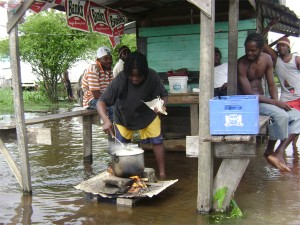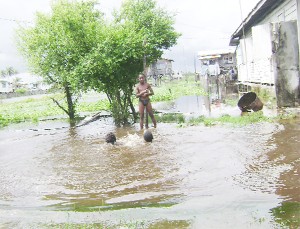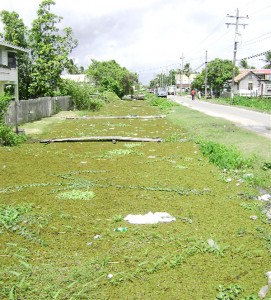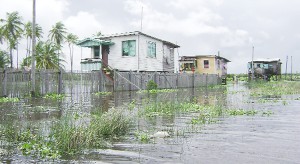Drainage authorities are still unable to provide answers to Dochfour villagers about the lack of maintenance of the Hope Koker as their flood misery dragged into a third week and a dam was poised to help in ridding the community of foetid water.

Dochfour has been under feet of smelly, brown water infested with snakes and insects for most of December. Residents have since suggested a solution to the National Drainage and Irrigation Authority (NDIA) which is currently in progress.
Residents suggested to officials that a dam be built along the area’s main drainage canal to increase its capacity and the floodwater from Dochfour be pumped into it thence to the Atlantic Ocean. The dam was still in progress when Stabroek News visited the area shortly before noon yesterday.

A resident, who only identified himself as Bobby, explained that the dam was almost finished and a pump was expected to be delivered to the area yesterday. However, up to late last evening this newspaper got no word of a pump being delivered to the Dochfour residents who are still swamped.
The Hope koker has been a burning issue in the Dochfour situation since it had not been functioning properly when flooding was first reported earlier this month. The koker had to be desilted sometime around December 12 and the Ministry of Agriculture had dismissed a Hope sluice attendant for allegedly neglecting to execute duties.

Chief Executive Officer (CEO) of the NDIA, Lionel Wordsworth, in an invited comment late yesterday afternoon confirmed that the koker had been desilted earlier this month. According to Wordsworth, prior to this the koker had been desilted during the May/June rainy season earlier this year. The Hope koker was open when this newspaper visited yesterday but the water appeared to be stagnant. It has thus far not been able to drain the floodwater from the community.
This newspaper learnt from a worker at the Hope Drainage Station/Koker that the employee who was fired had been employed in a management capacity. “…he is the man that used to overlook the koker and the pump stations and he was the man who had to record water level and so but he didn’t doing it properly,” the worker informed this newspaper. “I nah sure why he get knock off but he is the only person that get knock off from here this year.”

Wordsworth denied the worker’s statement. According to him, the person who was dismissed was an ordinary sluice attendant and did not operate in any managerial capacity.
The same worker also reported that the last time the Hope koker was desilted had been January. After that period, the worker explained, the koker had been left and did not function for nine months until it was serviced around December 12.
“That is untrue” were Wordsworth’s words when presented with this information. He reiterated that the koker had been maintained during the May/June period and again earlier this month.
Meantime, Dochfour is no longer the only village forced to use boats as their main transport. Residents of Victoria are paying boats $100 to get to their houses from Middle Walk Road.
Victoria: Another Dochfour?
Well above two feet of floodwater has driven many Victoria residents out of their homes and onto the street. This is where Stabroek News met a group of men cooking their lunch on Middle Walk Road yesterday.
Culverts are clogged, drains are overflowing, garbage and animal faeces are floating around the brown smelly water in Victoria. Residents told this newspaper that the water has been on the land just over three weeks but rainfall during the past few days and breaches in, and overtopping of the Victoria West Side Line Dam are causing the water to steadily rise.
While the water has been receding in a number of villages along the East Coast Demerara, flood woes appear to have only begun for the people of Victoria. Sections of the dam, residents reported, were breached as a result of several “village councils” selling the mud from the dam during the dry season. However, the excess rainfall has also caused the level of the Victoria Company Trench to rise and it has been flowing over certain areas along the dam thereby adding to the misery of residents.
When asked about the breaches in the Victoria dam yesterday the CEO of the NDIA only said that engineers were in the area addressing the issue and that he would be presented a full report before the end of the day. Efforts by Stabroek News late last evening to learn whether Wordsworth had received the report on the Victoria situation were futile.
Further, Wordsworth was informed about the alleged selling of the mud by the “village councils”. In response, he only told this newspaper the report on the Victoria situation would contain details on that as well.
Farmers from the area said that while the Minister of Agriculture, Robert Persaud, visited the area yesterday they have not been offered the amount of technical support they need. A team from the ministry, one farmer reported, had been in the area checking on their livestock’s health last Friday.
Livestock could be seen wandering along the streets when this newspaper visited the area shortly after 1 pm yesterday. Several farmers have reported suffering heavy losses because of the flood.
“Because my yard flooded my ducks going outside to look for dry place…they can’t be in the water all the time…when they go outside now other animals killing them. I had to shoot a cat today cause he only killing out me ducks,” farmer Herbert Kingston explained.
Like the residents of Dochfour many Victoria villagers are farmers and the flood is washing away their only means of supporting themselves. Food supplies are also being exhausted for a great number in the area.
“I invest all I had in my farm,” one resident said. “now that the flood wash it all away I have nothing left…the kero in my stove finish yesterday and I ain’t know how I going to cook…I got to go and find a lil work to get some money,” the depressed resident explained.
The water has been in the backlands of Victoria for so long that streets, walkways and yards have been transformed into soft slushy beds of mud. So in some areas, in addition to walking through feet of water, residents’ feet sink inches into the mud.




